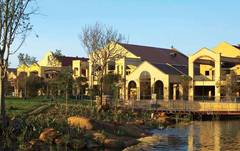 HomeProfilePortfolioAwardsMediaContact
HomeProfilePortfolioAwardsMediaContact

Green your Marketing
Amidst a whole new language of “green,” the definition of what constitutes green marketing is still being defined in a growing and dynamic marketplace.
By: Cheryl Adamson - Shopping SA August 2010
Ad hoc manifestations like printing on recycled paper, carbon neutral events, green event marketing, or just jumping on the green bandwagon of new hybrid brand idealisation and identification are all part of new marketing speak.
Jostling for more serious attention are terms like sustainable marketing and environmental marketing, but first and most importantly is the underlying concept of responsible marketing to avoid being labelled “greenwashing”.
Defining green marketing is not a simple task where terminology and meanings converge and sometimes contradict each other and the legal and consumer backlash of overstated marketing claims call for caution. Beyond the typical industry regulations for transparency and accountability, stands a consumer with a green whip in their hands and several stakeholders who are not really certain if they want to embark on the effort required to be truly sustainable.
Why is green marketing such a challenge in a playground full of opportunity? perhaps we should ask why in the building industry globally, going “green” is such a challenge?
Green House Gas emissions – whenever we hear this phrase, many of us are conditioned to visualise polluted industry, factories billowing smoke, and streets and highways filled with gas guzzling cars and buses, all signalling our imminent demise.
And while we are cognisant of making a certain contribution to climate change, and depleting energy resources, surely we cannot be the main culprits?
Yet, buildings are responsible for up to 40 % of total energy use worldwide and the potential and responsibility for drastic reductions of the energy consumption in buildings is thus very significant and falls squarely on our shoulders.
With proven and commercially available technologies, the energy consumption in both new and old buildings can be cut by an estimated 30% to 50% without significantly increasing investment costs. However, fragmentation and complexity of the construction sectors is cited worldwide as the greatest barriers to energy efficient buildings.
Let’s look at the shopping centre industry. Key stakeholders include developers, investment providers, designers, architects, engineers, contractors, agents, owners, tenants, and local government. The parties typically making decisions about building design (designers and investors) are seldom the ones who would benefit from a sustainable design and built approach including energy efficiency improvements and associated costs reductions (owners and tenants).
In existing centres the load of improved facilities management ultimately falls on the operations manager, many of whom are constrained by stringent cost parameters and decision – making, desiring to serve the needs of both the owners and managing agents. And so the see-saw begins – whose responsibility is it to initiate, who benefits, and how can marketing interact to translate a tangible and viable benefit to a consumer or customer?
Marketing with a scientific baseline? Integrated marketing? Marketing with the full buy in of the owners? We have all read those phrases before, but the holistic nature of green necessitates the complete involvement and participation of all three principles.
In the hallowed halls and ivory towers of creativity, the fist principle is to get buy in from the top. Whether the stimulation for a green campaign comes from the marketing consultancy with the desire to create a new centre USP, or from facilities management with a possible focus on cost savings, the only real impetus to move forward can come from the owner and few property owners would be willing to commit without some tangible evidence that this could be of benefit – which brings us to the baseline.
Much like the anxious “groom to be” asks the blessing of the father (landlord or owner), if the proposed marriage between marketing and operational management is to be consummated, best you have a good pre-nup! A detailed baseline of all resource consumption (energy, water, waste, human resources) needs to be compiled and documented as a benchmark that can continue to be audited regularly as the sustainable action plan moves forward.
Then and only then, can marketing, holding hands with operations and management, gingerly move forward – step by step, making sure they can actually sustain the idea they have created.
Is “green” relevant in the African context and is the marketing really beneficial?
Sustainable development is often defined as meeting “the needs of the present without compromising the ability of future generations to meet their own need”. However, a sober view on the local landscape would suggest that cost efficiency would drive the process at the moment more than the “feel good” factor. On the consumer side, we have a range of reactions. While few consumers are willing to trade an efficient washing powder for a soggy “green” version that will not clean her clothes like OMO, and millions of people worldwide don’t have the luxury of fretting over carbon emissions while trying to survive, “public opinion polls taken since the late 1980s have shown consistently that a significant percentage of consumers profess a strong willingness to favour environmentally conscious products and companies”.
Trend forecasters draw distinctions between the ECO-ICONIC consumers eager to flaunt their green behaviour and possessions, versus ECO-BOOSTERS who move from “merely” neutralising and offsetting undesirable eco effects to actually boosting the environment by something extra, and hopefully ECOEMBEDDED products and processes, which in time truly become embedded into daily life.
Despite the challenge of various definitions, an industry in its infancy and the lack of public consensus about what constitutes “green”, there is certainly growing global concern about climate change. This concern has led more companies to create awareness of their commitment to reduce their climate impact and the effect this has on their products and services. Is this just marketing? We think not. Perhaps the terminology should be the stimulation of goodwill towards a product or company – with the idea that goodwill is a sellable asset in the future. In this way, the diverse range of stakeholders of a shopping centre could be given an educated understanding of the sustainable efforts via meaningful communication.
So in conclusion, with the stretched resources we have on our planet (and in our own country), the building industry of which we are a sizable part, has a deep responsibility towards sustainability. From that obligation emanates a great opportunity to create and maximise goodwill from a sustainable initiative, whether that be your stakeholders, tenants, staff, or the shoppers we all serve.
Written by Cheryl Adamson from The A-Z Philosophy, winners of the Spectrum Award for Shopping Centre marketing Excellence for The Brightwater Commons (Integrated Category) for client Fountainhead Properties and in association with OrganiCarbon.


